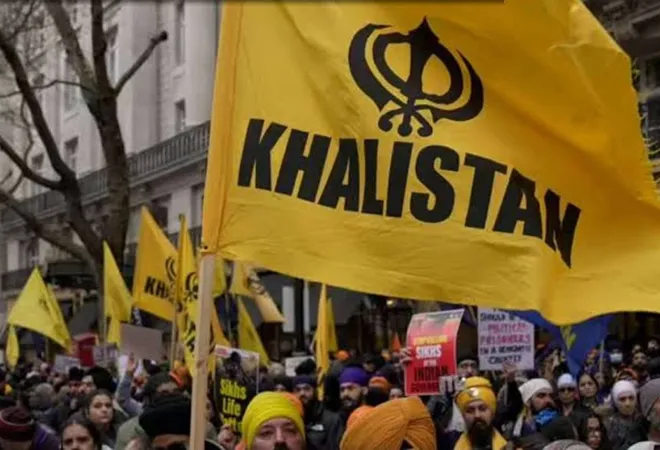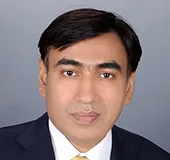
In the recent past, several incidents of Khalistani extremists attacking Hindu temples in
Australia and
Canada have come to light. The United Kingdom (UK) witnessed a violent protest by Khalistan extremists outside the
Indian High Commission (HC), in March 2023. Before that, UK-based Khalistanis protested outside the
Indian HC in 2018 and in October 2022. Sikhs For Justice (SFJ)—a Khalistani separatist outfit—organised a
referendum on Punjab’s secession. In Canada, SFJ organised a similar referendum in 2020. The spurt in Khalistani activism has perturbed the Indian strategic quarters. After the attack on the Indian HC in the UK, Delhi registered a strong protest, questioning the security lapses outside the HC’s premises. In November 2022, India expressed its disappointment and anguish with London for allowing demonstrations by
groups that “propagate violence, hatred, and secessionism”, despite India’s requests to consider its effects on bilateral ties.
The spurt in Khalistani activism has perturbed the Indian strategic quarters. After the attack on the Indian HC in the UK, Delhi registered a strong protest, questioning the security lapses outside the HC’s premises.
Khalistan’s modus-operandi in the West
Khalistani extremists are fringe groups constituting a very small section of the Sikh diaspora; however, they are extremely vocal, violent, and aggressive which gives the impression that they form a sizable majority of the population with an intimidating presence in social, cultural, religious, and political spaces.
In an exercise to explore the reasons, the author interviewed the members of the Sikh diaspora in Canada and the UK and some Sikh community leaders. In the interviews with members of the Sikh diaspora in the UK and Canada, the interlocutors informed that an overwhelmingly large number of Khalistani activists and supporters are from a lower socio-economic background with poor literacy levels, and are engaged in petty jobs. Many of them have taken asylum in Western countries and several of them are illegal immigrants. To prolong their stay and justify their case for asylum, they argue that their lives, liberty, and human rights are under threat in India. Such emotionally charged and rhetorical slandering and condemnation strengthen their case for seeking asylum or permanent residence.
Control over gurudwaras
They have robust control over the gurudwaras, giving them a powerful say in all community-related matters. The gurudwara is a fulcrum of any religious Sikh, be it marriages, religious rituals, social functions, or spiritual pursuits. Many Sikhs may remain dependent and vulnerable due to the Khalistani control over the gurudwaras. Terry Milswski, in his
report on Khalistani activities in Canada, mentions Pravakar Singh Dulai, a firebrand Khalistani activist holding a prominent position in Dashmesh Sahib Gurudwara in Surrey. Incidentally, the gurudwara also has a picture of Khalistan terrorist Talwinder Singh Parmar, the mastermind of the bomb explosion in Air India-182 flight from Montreal to London killing 329 people, honouring him as a martyr. A prominent community leader of the Sikh diaspora in Canada informed the author that many other gurudwaras have pictures of Bhindrawale, a Khalistani icon. Through gurudwaras, they generate huge funding for the cause. Further, he said that they also take money for social events like marriages or the Guru Granth Sahab’s worship at the individual devotees’ houses. Besides, the Khalistani management also seeks donations for community welfare which get diverted to extremist and subversive activities.
The gurudwara also has a picture of Khalistan terrorist Talwinder Singh Parmar, the mastermind of the bomb explosion in Air India-182 flight from Montreal to London killing 329 people, honouring him as a martyr.
Terror, intimidation, and threats
Sikh extremists control the narrative and leadership by intimidating and terrorising people. Most of the mainstream Sikhs maintain silence out of fear. Those who disagree with Khalistanis or speak against them, are intimidated or even killed. Reportedly, the
murder of Ripudaman Singh Malik (July 2022), a terrorist accused in the 1985 Air India bombing who was later acquitted, is one such case. It is said that Khalistani elements orchestrated his murder because lately, he had turned against them. He visited
India in 2019, wrote a letter thanking Indian Prime Minister Narendra Modi for his Sikh welfare measures, and
appealed to the Sikhs in Canada, not to “unfairly” criticise him.
Bloom Review also mentions that in their call for evidence, the Sikhs spoke under anonymity because they feared retribution. Many of them felt “disparaged, victimised, harassed or threatened by aggressive Sikh activists” for disagreeing with the Khalistani ideology. They were called “traitors,
nastik (atheist), impure and
patit (heretics)”.
Ujjwal Dossanj, former premier of British Columbia, was threatened and severely beaten for opposing the Khalistanis. Allegedly, the Khalistanis also
harassed Lord Singh of Wimbledon for giving unfavourable evidence on Sikh issues to the House of Lords Conducts committee. What strengthens Khalistanis’ terror-striking capabilities are their
strong ties with
gangsters, smugglers and human traffickers. Allegedly, they are using
Canada-based gangsters for targeted killings in Canada and India.
Influence over politics and state policy
Sikh extremists have also acquired a powerful presence through their control over the community votes. In Toronto, Brampton, Surrey, and Vancouver, the Khalistanis have a robust influence on the Sikh votes and play a decisive role in the election of local self-governing bodies. With huge gurudwara income, the Khalistanis also fund political parties and influence policies and laws. Their powerful penetration and influence over the state institutions are quite evident. Macdonald Laurier
Institute’s on Khalistani activities in Canada mentions that in 2018, they pressurised the Canadian government to replace “Sikh (Khalistani) extremist ideologies and movements” with a vague term “extremists” in the
Public Report on Terrorism Threat to Canada. Having realised that local bodies cannot give them enough say to influence policies at the national level and create a global anti-India narrative
, they are now directly entering into national-level politics. They also get emboldened by their massive monetary strength. A known Khalistan-sympathizer Jagmeet Singh, accused of leading the anti-India movement, heads a powerful national-level political party, New Democratic Party. Another example of Khalistani secessionist agenda making headway into the British
politics and state policy comes from the 2021 demand of including an additional tick-box option, allowing Sikhs to identify themselves as ethnic Sikhs, instead of the Indian ethnicity.
A known Khalistan-sympathizer Jagmeet Singh, accused of leading the anti-India movement, heads a powerful national-level political party, New Democratic Party.
Though Khalistanis constitute a “
small, extremely vocal and aggressive minority” of British Sikhs, but they have monopolised the community leadership in parliamentary engagement or deliberations with the state bodies. Apart from their control over the vote bank, the Western politicians’ insufficient understanding of the Sikh community issues, and faith practices is also a major factor leading to Khalistanis getting disproportionately high representation and leadership positions in politics.
The absence of counter-narrative
The absence of consistent and systematic counter-narratives makes the Khalistani networks’ spread much smoother. Khalistanis have a major disconnect with Sikhism’s fundamental teachings primarily rooted in Sanatan/Hindu texts. Baramulla-based Amanjit Singh, President of Sikh Youth of J&K, informed the author in a telephonic interview that most of the prestigious and historic Sikhs sampradayas (organisations) with a mass following such as Udasin, Nirmale Sampradaya, Nihang Sikhs, Sant Baba Ishar Singh Sampradaya, Car Sewa Sampraydaya, Nirankaris and Radhaswamis reject Khalistani version of Sikhism and identify themselves with Sanatan roots. Further, he said, among the Sikhs, except the Jutt Sikhs, the other communities like the Bhapa Sikhs (business class) and Mazhabi Sikhs (lower caste Sikhs) have no sympathy for Khalistan. However, there is no counter-narrative promoting these organisations and their beliefs, which captures the true essence of Sikhism. On the other hand, Khalistanis are very vocal and passionate about promoting their brand of Sikhism and weaning away the youth from traditional Sanatan Sikhism. Discussing the attitude of traditional Sikhs towards Khalistanis, Amanjit Singh said that with their overly ritualistic Sikhism, dissociated from Hinduism, they are perceived as Wahabbi equivalents in Sikhism by the traditional Sanatani Sikhs. There are interesting parallels between them and Wahabbi preachers like Zakir Naik, particularly in the use of technology to indoctrinate youth. If a robust counter-narrative originates from Indian Punjab, it will go a long way in delegitimising Khalistani discourse in the Western world.
Khalistanis are very vocal and passionate about promoting their brand of Sikhism and weaning away the youth from traditional Sanatan Sikhism.
Pakistani intelligence footprint
Khalistani activities have a strong Pakistani intelligence footprint, manifest in their strategy, tactics, advocacy, information war, and operational matters of terrorist activities in India. Pakistan’s decades-long experience in manipulating Western societies, circumventing liberal political order, and spreading fake anti-India propaganda, provides a ready template for Khalistanis. Allegedly, Pakistan army’s Lt. Col Shahid Mohammad Malhi is the
key architect of Referendum 2020, named as “Operation Express” by the Inter-Services Intelligence (ISI). Borrowing ISI’s playbook, Khalistani groups like SFJ and many others masquerade as human rights organisations, seeking legitimacy in the Western world which puts a premium on freedom of expression. Further, like ISI proxies, the Khalistani groups use many aliases to create smokescreens. Canada’s McDonald Laurier Institute and the US’
Hudson Institute have produced detailed reports on Khalistani connections with Pakistan. Notably, Khalistan’s map as shown in the
McDonald report, does not include Pakistani Punjab. Also, Khalistanis never raise the issue of ill-treatment, forced conversions, abductions, and cultural genocide of Sikhs in Pakistan and Afghanistan by Islamic extremists, making sure that their Pakistani benefactors are not displeased. Hudson Institute has listed 55 Kashmiri and Khalistani organisations working in close coordination. Reportedly, they organise joint events, and protests, and share lawyers, donors, and accountants.
Having discussed the Khalistan modus-operandi, it is reasonable to argue that an appropriate policy response can be developed to counter the Khalistani threat to India and Western countries’ internal security and India’s relations with the West. However, it is pertinent to mention that
Western countries have been reluctant to understand India’s concerns in this regard. Many Indian experts argue that the West plays softball with Kashmiri, Khalistani, and other anti-India lobbies to pressurise India on human rights and democracy, as a tool of their statecraft.
If this continues, it will be a major stumbling block in strengthening the trust and comfort between the West and India.
Abhinav Pandya is founder and CEO of Usanas Foundation, an India-based geopolitical and security affairs think-tank.
The views expressed above belong to the author(s). ORF research and analyses now available on Telegram! Click here to access our curated content — blogs, longforms and interviews.



 In the recent past, several incidents of Khalistani extremists attacking Hindu temples in
In the recent past, several incidents of Khalistani extremists attacking Hindu temples in  PREV
PREV


